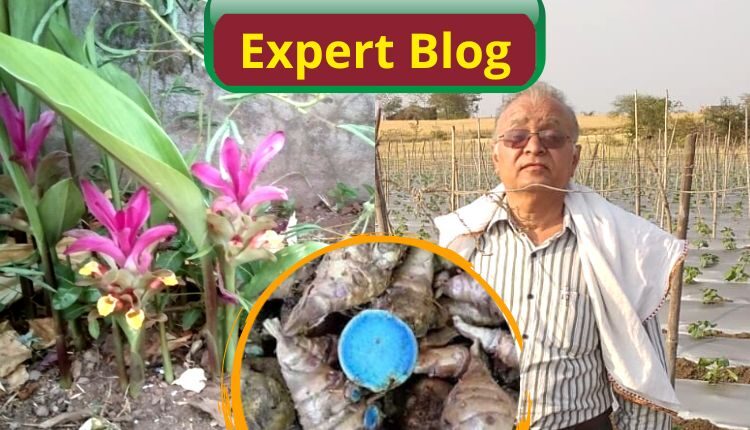Black Turmeric: How black turmeric farming beneficial for farmers?
If these systems will be adopted in the crop of black turmeric, then it will be beneficial
How can black turmeric be cultivated? What are the important things to keep in mind? Special conversation with Rajesh Kumar Mishra, Senior Horticulture Officer (Retd) with Kisan of India.
You must have heard about yellow turmeric till now. Turmeric is used as a spice in food. But do you know that apart from yellow, there is also black turmeric? Yes, its benefits are unmatched. Due to its medicinal properties, its price is also high in the market. Here we will give you important information related to the cultivation of black turmeric.
Benefits of Black Turmeric
Black turmeric is used as a herb in Ayurveda due to its antibiotic properties. It is also used in cosmetics. Black turmeric is used to heal wounds, sprains, skin diseases, improve digestion and cure liver problems. It helps in reducing cholesterol. The scientific name of black turmeric is Curcuma caesia. It is also called ‘Black Jedori’ in English.

Climate for cultivation of black turmeric
For cultivation of black turmeric, the temperature should be 15 to 40 degree centigrade. Warm climate is best suited for this. Its plants are also capable of withstanding frost. Its plants maintain adaptation even in adverse weather.
Identification of Black Turmeric Tubers and Plants
Tubers or rhizomes of black turmeric are cylindrical, black in colour. When dried, they turn into solid crystals. Black turmeric plants are 30 to 60 cm high without stem. The leaves are broad lanceolate and there is a long line in the middle of the leaves. The colour of flowers on the black turmeric plant is pink.

Which soil is suitable for cultivation of black turmeric?
For the cultivation of black turmeric, sandy, loam, matiyar, medium water holding land is best. Keep in mind that black turmeric tubers do not develop in smooth black mixed soil. There should be plenty of fossils in the soil. It cannot be cultivated in waterlogged or less fertile land. The pH value of the land should be between 5 to 7 for its cultivation.
Field preparation for cultivation of black turmeric
Deep plow the field with earth turning plow. Leave the field open for a few days to get sunlight. Then add dung manure in prescribed quantity and mix it well in the soil. To mix the manure with the soil, plow the field two to three times diagonally. After plowing, run water in the field and make it clear. After ploughing, when the soil of the field starts drying from above, then plow the field again. Make the soil crumbly by running rotavator in it. After that level the field.
Sowing time and Seed quantity
Black turmeric plants can be sown in the month of June-July during the rainy season. It can also be planted in the month of May if there is adequate means of irrigation. About 20 quintals of seeds (tubers) are required for cultivation of black turmeric per hectare.

How to do black turmeric seed treatment?
Its tubers should be treated with appropriate amount of Bavistin fungicide before transplanting. The tubers should be kept immersed in 2% solution of Bavistin for 15 to 20 minutes because in its cultivation, the cost of seed is high.
How to transplant black turmeric?
Black turmeric tubers are planted in rows. There should be a distance of one and a half to 2 feet between each row. The distance between the tubers to be planted in rows should be around 20 to 25 cm. The tubers should be planted in the ground at a depth of 7 cm. In the form of a plant, it is planted by making a ridge. There should be a distance of one to one and a half feet between each ram. The distance between the plants on the ridge should be 25 to 30 cm. The width of the ram should be around half a foot.
How to prepare plant?
Black turmeric can also be planted by preparing its seedlings. To prepare its seedlings, its tubers are transplanted by filling soil in trays or polythene. Its tubers should be treated with appropriate amount of Bavistin before transplanting. Its tubers are ready for transplanting in the field two months after transplanting in nursery. There are 1100 plants in one hectare. Planting is done at the beginning of the rainy season.
When to irrigate?
Black turmeric plants do not require much irrigation. Its tubers are planted in moist soil. Immediately after transplanting its tubers or seedlings, irrigation should be done. In mild hot weather, its plants should be watered at an interval of 10 to 12 days. Irrigation should be done at an interval of 15 to 20 days during winter season.

Fertilizers
At the time of preparation of the field, old dung manure should be mixed with the soil and given to the plants. 10 to 12 tonnes of decomposed cow dung should be added per acre. Jeevamrut prepared at home should be given along with irrigation of plants.
Weed control
Weed control is done through weeding. Light weeding is done 25 to 30 days after transplanting the plants. 3 hoeing is sufficient for weed control. Do each weeding at an interval of 20 days. Weeding should be stopped after 50 days of transplanting, otherwise the tubers will be damaged.

How to do soil plating and pest control?
Two months after transplanting, soil should be applied to the roots of the plants. Soil should be applied after every one to two months. Organic insecticides can be sprayed to control pests.
Digging and yield of tubers
Its crop is ready for harvesting about 250 days after transplanting. The tubers are dug from January to March. Its yield is estimated to be 2 to 2.5 kg per plant. There are 1100 saplings in one hectare, which gives a yield of 48 tonnes. The yield per acre is about 12 to 15 tonnes, which dry up to 1 to 1.5 tonnes.
Author :
Rajesh Kumar Mishra
Senior Horticulture Officer (Retd)
Sagar, Madhya Pradesh
Contact us: If farmers want to share information or experiences related to farming with us, then they can do this by calling us on the phone number 9599273766 or by writing an email to [email protected] or by sending your recording. Through Kisan of India, we will convey your message to the people, because we believe that if the farmers are advanced then the country is happy.



